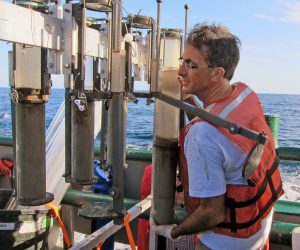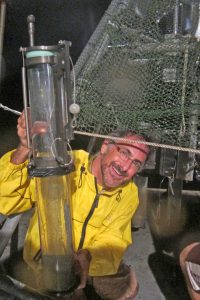Study Reveals Oil Spill Changed Oxygen Conditions in Gulf Sediment
– May 26, 2015
A team of scientists from Eckerd College and University of South Florida conducted a time-series sediment study to better understand impacts from the Deepwater Horizon oil spill.
Three years post-spill, they found a continued state of altered geochemical conditions in sediment near the spill site. Concentrations of manganese, rhenium, and cadmium in sediment indicated a large organic carbon influx and subsequent decreases in oxygen concentrations. Decreases in the density of benthic foraminifera coincided with these altered conditions, suggesting potential impacts on benthic ecosystems. The researchers published their findings in Deep Sea Research Part II: Topical Studies in Oceanography: Changes in sediment redox conditions following the BP DWH blowout event.
During and after the oil spill, scientists observed increased microbial activity and the forming, sinking, and settling of hydrocarbon enriched marine snow on the sea floor. The purpose of this study was to improve understanding about the association of these biological responses to the large hydrocarbon influx from the oil spill and identify potential impacts on the deep ocean environment.
Researchers analyzed concentrations of metals that indicate low oxygen and anoxic conditions as a means to track changes to the natural cycle that takes place when carbon gradually settles on the ocean’s floor and slowly becomes incorporated into sediment. Peaks in manganese indicate the upper boundary of a geochemical cycle in sediment known as redoxcline. Enrichments of rhenium and cadmium indicate low oxygen or reducing conditions beneath that upper boundary of manganese.
The team established pre-spill baseline profiles of manganese, rhenium, and cadmium using sediment cores collected in 2007 and 2009 and two weeks after the oil spill, prior to the substantial organic carbon sedimentation that scientists observed in the months following the spill. They determined post-spill profiles of these metals using sediment cores collected between August 2010 and August 2013.
Pre-spill concentrations of these metals were typical of continental slope sediments. Post-spill metal concentrations showed noticeable differences in the top 5-30 millimeters of sediment, with rhenium concentrations 3 – 4 times higher than background levels. These metal enrichments demonstrated a change in post-spill sediment conditions, likely as a result of organic carbon remineralization.
The team analyzed benthic foraminifera that live in the upper sediment layers as potential indicators of impacts from shifting redoxcline conditions. Decreases in the density of benthic foraminifera were coincident with the changes in metal concentrations at the same depth range. In December 2010 there was a 40-60% reduction in the two most abundant genera of benthic foraminifers, and in February 2011 there remained a reduction in the genera.
In their discussion, the researchers noted that the more subtle changes in manganese, rhenium, and cadmium concentrations deeper in sediment suggest that a marine snow event associated with the oil spill likely contributed to the changed conditions closer to the seafloor. Diminishing rhenium and cadmium concentrations in sediment cores collected in the third year may signal a return to pre-spill conditions. Continued assessment of metal concentrations can help describe the temporal evolution of sediment conditions and document potential long-term effects as well as a possible return to background conditions.
This study’s authors are D.W. Hastings, P.T. Schwing, G.R. Brooks, R.A. Larson, J.L. Morford, T. Roeder, K.A. Quinn, T. Bartlett, I.C. Romero, and D.J. Hollander.
************
This research was made possible in part by grants from the Gulf of Mexico Research Initiative (GoMRI) to the Center for Integrated Modeling and Analysis of Gulf Ecosystems (C-IMAGE), Deepsea to Coast Connectivity in the Eastern Gulf of Mexico (DEEP-C) consortium, and the Florida Institute of Oceanography (FIO).
The Gulf of Mexico Research Initiative (GoMRI) is a 10-year independent research program established to study the effect, and the potential associated impact, of hydrocarbon releases on the environment and public health, as well as to develop improved spill mitigation, oil detection, characterization and remediation technologies. An independent and academic 20-member Research Board makes the funding and research direction decisions to ensure the intellectual quality, effectiveness and academic independence of the GoMRI research. All research data, findings and publications will be made publicly available. The program was established through a $500 million financial commitment from BP. For more information, visit https://gulfresearchinitiative.org/.
© Copyright 2010- 2017 Gulf of Mexico Research Initiative (GoMRI) – All Rights Reserved. Redistribution is encouraged with acknowledgement to the Gulf of Mexico Research Initiative (GoMRI). Please credit images and/or videos as done in each article. Questions? Contact web-content editor Nilde “Maggie” Dannreuther, Northern Gulf Institute, Mississippi State University (maggied@ngi.msstate.edu).







